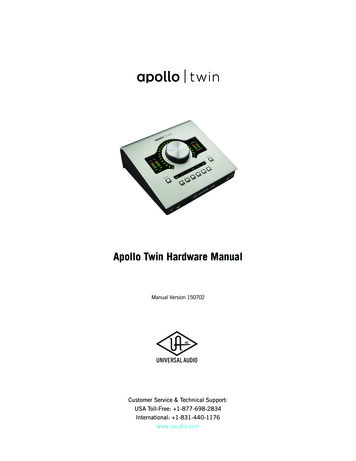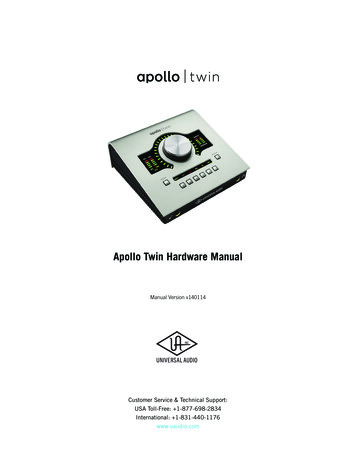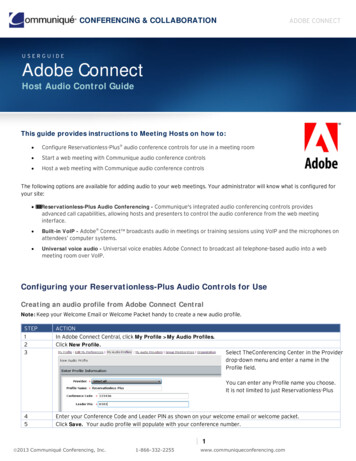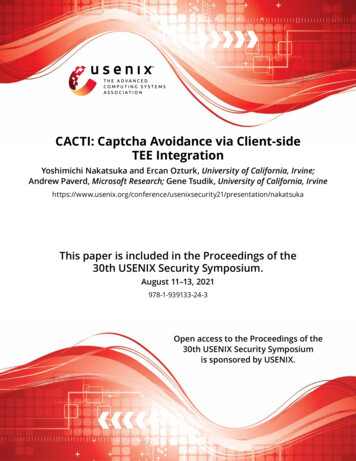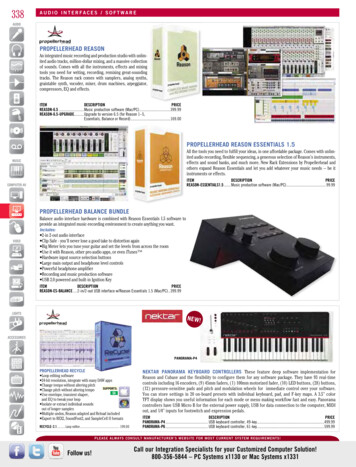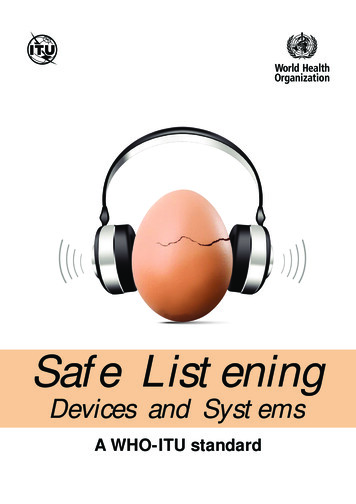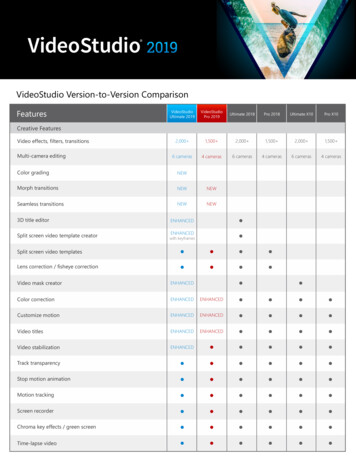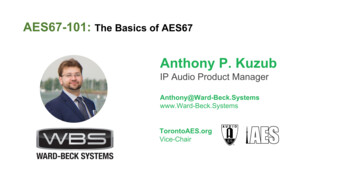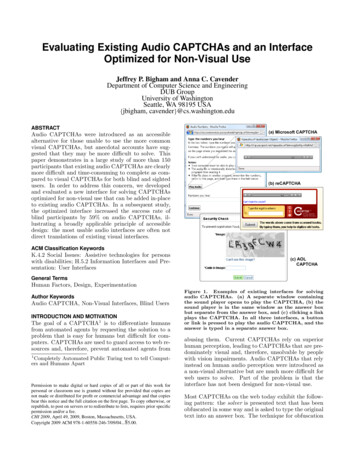
Transcription
Evaluating Existing Audio CAPTCHAs and an InterfaceOptimized for Non-Visual UseJeffrey P. Bigham and Anna C. CavenderDepartment of Computer Science and EngineeringDUB GroupUniversity of WashingtonSeattle, WA 98195 USA{jbigham, cavender}@cs.washington.eduABSTRACTAudio CAPTCHAs were introduced as an accessiblealternative for those unable to use the more commonvisual CAPTCHAs, but anecdotal accounts have suggested that they may be more difficult to solve. Thispaper demonstrates in a large study of more than 150participants that existing audio CAPTCHAs are clearlymore difficult and time-consuming to complete as compared to visual CAPTCHAs for both blind and sightedusers. In order to address this concern, we developedand evaluated a new interface for solving CAPTCHAsoptimized for non-visual use that can be added in-placeto existing audio CAPTCHAs. In a subsequent study,the optimized interface increased the success rate ofblind participants by 59% on audio CAPTCHAs, illustrating a broadly applicable principle of accessibledesign: the most usable audio interfaces are often notdirect translations of existing visual interfaces.(a) Microsoft CAPTCHA(b) reCAPTCHAACM Classification KeywordsK.4.2 Social Issues: Assistive technologies for personswith disabilities; H.5.2 Information Interfaces and Presentation: User Interfaces(c) AOLCAPTCHAGeneral TermsHuman Factors, Design, ExperimentationAuthor KeywordsAudio CAPTCHA, Non-Visual Interfaces, Blind UsersINTRODUCTION AND MOTIVATIONThe goal of a CAPTCHA1 is to differentiate humansfrom automated agents by requesting the solution to aproblem that is easy for humans but difficult for computers. CAPTCHAs are used to guard access to web resources and, therefore, prevent automated agents from1Completely Automated Public Turing test to tell Computers and Humans ApartPermission to make digital or hard copies of all or part of this work forpersonal or classroom use is granted without fee provided that copies arenot made or distributed for profit or commercial advantage and that copiesbear this notice and the full citation on the first page. To copy otherwise, orrepublish, to post on servers or to redistribute to lists, requires prior specificpermission and/or a fee.CHI 2009, April 49, 2009, Boston, Massachusetts, USA.Copyright 2009 ACM 978-1-60558-246-7/09/04. 5.00.Figure 1. Examples of existing interfaces for solvingaudio CAPTCHAs. (a) A separate window containingthe sound player opens to play the CAPTCHA, (b) thesound player is in the same window as the answer boxbut separate from the answer box, and (c) clicking a linkplays the CAPTCHA. In all three interfaces, a buttonor link is pressed to play the audio CAPTCHA, and theanswer is typed in a separate answer box.abusing them. Current CAPTCHAs rely on superiorhuman perception, leading to CAPTCHAs that are predominately visual and, therefore, unsolvable by peoplewith vision impairments. Audio CAPTCHAs that relyinstead on human audio perception were introduced asa non-visual alternative but are much more difficult forweb users to solve. Part of the problem is that theinterface has not been designed for non-visual use.Most CAPTCHAs on the web today exhibit the following pattern: the solver is presented text that has beenobfuscated in some way and is asked to type the originaltext into an answer box. The technique for obfuscation
is chosen such that it is difficult for automated agentsto recover the original text but humans should be ableto do so easily. Visually this most often means thatgraphic text is displayed with distorted characters (Figure 1). In audio CAPTCHAs, this often means text issynthesized and mixed in with background noise, suchas music or unidentifiable chatter. Although the twotypes of CAPTCHAs seem roughly analogous, the usability of the two types of CAPTCHAs is quite differentbecause of inherent differences in the interfaces used toperceive and answer them.Visual CAPTCHAs are perceived as a whole and canbe viewed even when focus is on the answer box. Oncefocusing the answer box, solvers can continue to lookat visual CAPTCHAs, edit the answer that they provided, and verify their answer. They can repeat thisprocess until satisfied without pressing any keys otherthan those that form their answer. Errors primarilyarise from CAPTCHAs that are obfuscated too muchor from careless solvers.Audio playback is linear. A solver of an audio CAPTCHA first plays the CAPTCHA and then quickly focuses the answer box to provide their answer. For sightedsolvers, focusing the answer box involves a single clickof the mouse, but for blind solvers, focusing the answerbox requires navigating with the keyboard using audiooutput from a screen reader. Solving audio CAPTCHAsis difficult, especially when using a screen reader.Screen readers voice user interfaces that have been designed for visual display, enabling blind people to access and use standard computers. Screen readers oftenspeak over playing CAPTCHAs as solvers navigate tothe answer box, speaking the interface but also talking over the CAPTCHA. A playing CAPTCHA willnot pause for solvers as they type their answer or deliberate about what they heard. Reviewing an audioCAPTCHA is cumbersome, often requiring the user tostart again from the beginning, and replaying an audioCAPTCHA requires solvers to navigate away from theanswer box in order to access the controls of the audioplayer. The interface to audio CAPTCHAs was not designed for helping blind users solve them non-visually.Audio CAPTCHAs have been shown previously to bedifficult for blind web users. Sauer et al. found thatsix blind participants had a success rate of only 46% insolving the audio version of the popular reCAPTCHA[18], and Bigham et al. observed that none of the fifteen blind high school students in an introductory programming class were able to solve the audio CAPTCHA guarding a web service required for the course [3].In this paper, we present a study with 89 blind webusers who achieved only a 43% success rate in solving10 popular audio CAPTCHAs. On many websites, unsuccessful solvers must try again on a new CAPTCHAwith no guarantee of success on subsequent attempts, afrustrating and often time-consuming experience.Given its limitations, audio may be an inappropriatemodality for CAPTCHAs. Developing CAPTCHAs thatrequire human intelligence that computers do not yethave seems an ideal alternative, but the development ofsuch CAPTCHAs has proven elusive [7]. CAPTCHAscannot be drawn from a fixed set of questions and answers because doing so would make them easily solvable by computers. Computers are quite good at themath and logic questions that can be generated automatically. Audio CAPTCHAs could also be made moreunderstandable, but that could also make them easierfor computers to solve automatically.The new interface that we developed improves usability without changing the underlying audio CAPTCHAs.By moving the interface for controlling playback directly into the answer box, a change in focus (and thus achange in context) is not required. Using the new interface, solvers have localized access to playback controlswithout the need to navigate from the answer box to theplayback controls. Solvers also do not need to memorizethe CAPTCHA, hurry to navigate to the answer boxafter starting playback of the CAPTCHA, or solve theCAPTCHA while their screen readers are talking overit. Solvers can play the CAPTCHA without triggeringtheir screen readers to speak, type their answer as theygo, pause to think or correct what they have typed, andrewind to review - all from within the answer box.Because popular audio CAPTCHAs have similarities intheir interfaces, our optimized interface can easily beused in place of these existing interfaces. Both the ideasand interface itself are likely to be applicable to CAPTCHAs yet to be developed. Finally, the design considerations explored here have application to improving awide range of interfaces for non-visual access.This paper offers the following four contributions: A study of 162 blind and sighted web users showing that popular audio CAPTCHAs are much moredifficult than their visual counterparts. An improved interface for solving audio CAPTCHAsoptimized for non-visual use that moves the controlsfor playback into the answer box. A study of the optimized interface indicating that itincreases the success rate of blind web users on popular CAPTCHAs by 59% without altering the underlying CAPTCHAs. An illustration via the optimized interface that usableinterfaces for non-visual access should not be directlyadapted from their visual alternatives without considering differences in non-visual access.RELATED WORKCAPTCHAs were developed in order to control accessto online resources and prevent access by automatedagents that may seek to abuse these resources [22]. As
their popularity increased, so did the concern that theCAPTCHAs used were primarily based on the superiority of human visual perception, and therefore excludedblind web users. Although audio CAPTCHAs were introduced as an accessible alternative, the interface usedto solve them did not consider the lessons of prior workon optimizing interfaces for non-visual use.Making CAPTCHAs AccessibleAudio CAPTCHAs were introduced soon after their visual alternatives [22, 9], and have been slowly adoptedby web sites using visual CAPTCHAs since that time.Although the adoption of audio CAPTCHAs has beenslower than that of visual CAPTCHAs, many popularsites now include audio alternatives, including servicesoffered by Google and Microsoft. Over 2600 web usershave signed a petition asking for Yahoo to provide anaccessible alternative [25]. The reCAPTCHA project,a popular, centralized CAPTCHA service with the goalof improving the automated OCR (Optical CharacterRecognition) processing of books also provides an audioalternative. Although audio CAPTCHAs exist, theirusability has not been adequately examined.Researchers have quantified the difficulty that users havesolving both audio and visual CAPTCHAs. For instance, Kumar et al. explored the solvability of visual CAPTCHAs while varying their difficulty on several dimensions [6]. Studies on audio CAPTCHAs havebeen smaller but informative. For instance, Sauer etal. conducted a small usability study (N 6) in orderto evaluate the effectiveness of the reCAPTCHA audioCAPTCHA [18]. They noted that participants in thestudy employed a variety of strategies for solving audioCAPTCHAs. Four participants memorized the characters as they were being read and then entered theminto the answer box after the CAPTCHA had finishedplaying and one participant used a separate note taking device to record the CAPTCHA characters as theywere read. They noted that the process of solving thisaudio CAPTCHA was highly error-prone, resulting inonly a 46% success rate. The study presented in thenext section expands these results to a diverse selection of popular CAPTCHAs in use today and furtherillustrates the frustration and strategies that blind webusers employ to solve audio CAPTCHAs.The usability of CAPTCHAs for human users must beachieved while maintaining the inability of automatedagents to solve them. Although visual CAPTCHAshave had the highest profile in attempts to break them,audio CAPTCHAs have recently faced similar attempts[20]. As audio CAPTCHAs are increasingly made thetarget of automated attacks, changes that make themeasier to understand will be less likely to be adopted outof concern that they will make automated attacks easieras well. Changing the interface used to solve a CAPTCHA, however, only impacts the usability for humansolvers.The audio CAPTCHAs described earlier are currentlythe most popular type of accessible CAPTCHA, butthey are not the only approach pursued. Holman et al.developed a CAPTCHA that pairs pictures with thesounds that they make (for instance, a dog is pairedwith a barking sound) so that either the visual or audio representation can be used to identify the subjectof the CAPTCHA [8]. Tam et al. proposed phrasedbased CAPTCHAs that could be more obfuscated thancurrent audio CAPTCHAs but remain easy for humansto solve because human solvers will be able to rely oncontext [20]. The improvements provided by our optimized interface to audio CAPTCHAs could be adaptedto both of these new approaches should they be shownto be better alternatives.Other AlternativesBecause audio CAPTCHAs remain difficult to use andare not offered on many web sites, several alternativeshave been developed supporting access for blind webusers. Many sites require blind web users to call oremail someone to gain access. This can be slow and detracts from the instant gratification afforded to sightedusers. The WebVisum Firefox extension enables webusers to submit requests for CAPTCHAs to be solved,which are then forwarded to their system to be solvedby a combination of automated and manual techniques[24]. Because of the potential for abuse, the system iscurrently offered by invitation only and questions remain about its long-term effectiveness. For many blindweb users the best solution continues to be asking asighted person for assistance when required to solve avisual CAPTCHA.Combinations of (i) new approaches to creating audioCAPTCHA problems and (ii) interfaces targeting nonvisual use promise to enable blind web users to independently solve CAPTCHAs in the future. This paperdemonstrates the importance of the interface.Targeting Non-Visual AccessThe interface that we developed for solving audio CAPTCHAs builds on work considering the development ofnon-visual interfaces. Such interfaces are often very different than the interfaces developed for visual use eventhough they enable equivalent interaction. For instance,in the math domain, specialized interfaces have beendeveloped to make navigation of complex mathematicsfeasible in the linear space exposed by non-visual interfaces [16]. Emacspeak explores the usability improvement resulting from applications designed for non-visualaccess instead of being adapted from visual interfaces[17].With the increasing importance of web content, muchwork has targeted better non-visual web access. Forinstance, the HearSay browser converts web pages intosemantically-meaningful trees [15] and, in some circumstances, automatically directs users to content in a webpage that is likely to be interesting to them [11]. Trail-
Blazer suggests paths through web content for users tofollow, helping them avoid slow linear searches throughcontent [5]. A common theme in work targeting webaccessibility is that content should be accessed in a semantically meaningful way and functionality should beeasily available from the context in which it most makessense.The aiBrowser for multimedia web content enables usersto independently control the volume of their screen readerand multimedia content on the web pages they view[12]. Without the interface provided by aiBrowser, content on a web page can begin making noise (for instance,playing a song in an embedded sound player or Flashmovie) making screen readers difficult to hear. Thisaudio clutter can make navigating to the controls ofthe multimedia content using a screen reader difficult,if controls are provided for the multimedia content atall. One of the goals of our optimized interface to audioCAPTCHAs is to prevent CAPTCHAs from starting toplay before the user is in the answer field where they willtype their answers - a major complaint of our study participants concerning how audio CAPTCHAs work currently. Just as with the aiBrowser, the goal is, in part,to give users finer control over the audio channel usedby both their screen readers and other applications.Work in accessibility has also explored the differencebetween accessibility and usability. Many web sites aretechnically accessible to screen reader users, but theyare inefficient and time-consuming access. Prior workhas shown that the addition of heading elements to semantically break up a web page or the use of skip linksto enable users to quickly skip to the main content of apage can increase its usability [21, 23]. Audio CAPTCHAs are accessible non-visually, but their usability isquite poor for most blind web users. Our new interfacehelps to improve usability.EVALUATION OF EXISTING CAPTCHASMany web services now offer audio CAPTCHAs becausethey believe them to be an accessible alternative to visual CAPTCHAs. However, the accessibility and usability of these audio CAPTCHAs has not been extensively evaluated. Our initial study aims to evaluate theaccessibility of existing audio CAPTCHAs and searchfor implications we could use to improve them. Wedid this by gathering currently used CAPTCHAs fromthe most popular web services and presented them tostudy participants to solve. During the study, we collected tracking data to investigate the means by whichboth sighted and blind users solve CAPTCHAs. Thetracking data we collected allowed us to analyze thetiming (from page load to submit) of every key pressedand button clicked, and search for problem areas andpossible improvements to existing CAPTCHAs.Existing Audio CAPTCHAsTo gather existing audio CAPTCHAs for our study, weused Alexa [1], a web tracking and statistic gatheringFeatures of Audio CAPTCHAsAOLAuthCraigslist DIGGorizeFacebookGoogle MS-Live OfferedBeeps3000130001BeforeBackgroundvoice none music static voice voice voice static none voiceNoiseChallengeA-Z A-ZA-ZA-Z 0-90-90-9A-Z Word 0-9Alphabet0-90-9Duration10.2 5.19.36.9 24.7 40.9 7.14.33.0 25.1(sec)RepeatnonononononononoyesnoFigure 2. A summary of the features of the CAPTCHAsthat we gathered. Audio CAPTCHAs varied primarilyalong the several common dimensions shown here.service, to determine the most popular web sites visitedfrom the United States as of July 2008. Of the top 100,38 used some form of CAPTCHA, and of those less thanhalf (47%) had an audio CAPTCHA alternative. Forour study, we chose to only include sites offering bothvisual and audio CAPTCHAs and avoided sites usingthe same third party CAPTCHA services.Using this method we chose 10 unique types of CAPTCHAs that represent those used by today’s most popular websites: AOL (aol), Authorize.net payment gateway service provider (authorize), craigslist.org onlineclassifieds (craigslist), Digg content sharing forum (digg),Facebook social utility (facebook), Google (google), Microsoft Windows Live individual web services and software products (mslive), PayPal e-commerce site (paypal), Slashdot technology-related news website (slashdot), and Veoh Internet television service (veoh). Foreach of the 10 CAPTCHA types we downloaded 10 examples, resulting in a total of 100 audio CAPTCHAsused for the study (Figure 2).Several of these sites attempted to block the downloadof the audio files representing each CAPTCHA althoughall of them were in either the MP3 or WAV format.Many sites added the audio files to web pages using obfuscated Javascript and would allow each to be downloaded only once. These techniques at best marginallyimprove security, but can often hinder access to userswho may want to play the audio CAPTCHA with aseparate interface that is easier for them to use.Study DescriptionTo conduct our study, we created interfaces for solving visual and audio CAPTCHAs mimicking those weobserved on existing web pages (Figure 3). The interface for visual CAPTCHAs consisted of the CAPTCHAimage, an answer field, and a submit button. The interface for solving audio CAPTCHAs replaced the imagewith a play button that when pressed caused the audioCAPTCHA to play. These simplified interfaces preservethe necessary components of the CAPTCHA interface,enabling interface components to be isolated from thesurrounding content. Solving CAPTCHAs in real web
Separate Play ButtonSeparate Answer FieldFigure 3. An interface to solving audio CAPTCHAsmodeled after those currently provided to users to solveaudio CAPTCHAs (Figure 1).The data recorded enabled us to make observations, including the time required to answer the CAPTCHA,how many times the CAPTCHA was played, how manymistakes were made in the process of answering a CAPTCHA, and the number of attempts required. The fulllist of the events gathered and the information recordedfor each is shown below: Page Loaded - the web page has loaded. Focused Play - participant selected the play button.pages may be more difficult as there are additional distractions, such as other content, and the CAPTCHAmay need to be solved with a less ideal interface, forinstance using a pop-up window. Pressed Play - participant pressed the play button.Our study was conducted remotely. As Petrie et al.observed, conducting studies with disabled people in alab setting can be difficult, but remote studies can produce similar results [13]. Blind users in particular usemany different screen readers and settings that wouldbe difficult to replicate fully in a lab setting, meaningthe remote studies can better approximate the true performance of participants. Answer Box Focused - participant entered the answer box either by clicking on it or tabing to it.Participants were first presented with a questionnaireasking about their experience with web browsing, experience with CAPTCHAs and the level of difficultyor frustration they present, as well as demographic information. They were then asked to solve 10 visualCAPTCHAs and 10 audio CAPTCHAs (for sighted participants) or 10 audio CAPTCHAs (for blind participants). Each participant was asked to solve one problem randomly drawn from each CAPTCHA type, andthe CAPTCHA types were presented in random orderto help avoid ordering effects.For this study, participants were designated as belonging to the blind or sighted condition based on their response to the question: “How do you access the web?”The following answers were provided as options: “I amblind and use a screen reader,” “I am sighted and use avisual browser,” and “Other.” In this paper, blind participates will refer to those who answered with the firstoption and sighted participants to those who answeredwith the second option.Participants were given up to 3 chances to correctlysolve each CAPTCHA, but of primary concern was theirability to correctly solve each CAPTCHA on the firsttry because this is what is required by most existingCAPTCHAs.To instrument our study, we included Javascript tracking code on each page of the study that allowed us tokeep track of the keys users typed and other interaction with page elements. This approach is similar tothat provided by the more general UsaProxy [2] systemwhich records all user actions in the browser when usersconnect through its proxy. This approach has also beenused before in studies with screen reader users [4]. Blurred Play - participant moved away from theplay button. Answer Box Blurred - participant exited the answer box either by clicking out or moving away. Key Pressed - participant pressed a keyboard key. Focused Submit - submit button was selected. Pressed Submit - submit button was pressed. Blurred Submit - participant moved away from thesubmit button without pressing it. Incorrect Answer - the answer provided by the participant is incorrect, leading the participant to be presented with a 2nd or 3rd try.Personally identifying information was not recorded.ResultsOf our 162 participants, 89 were blind and 73 weresighted; 56 were female, 99 were male, and 7 chose notto answer that question; and their ages ranged from 18to 69 with an average age of 38.0 (SD 13.2).Before participating in our study, blind and sightedparticipants showed differing levels of frustration toward the audio and visual CAPTCHAs they had already come across. Participants were asked to ratethe following questions on a scale from Strongly Agree(1) to Strongly Disagree (5) or opt out by answering “Ihave never independently solved a visual[audio] CAPTCHA” for the following questions: “Audio CAPTCHAsare frustrating to solve.” and “Visual CAPTCHAs arefrustrating to solve.”For the question about audio CAPTCHAs, averagesfrom the two groups were similar, 2.73 (SD 1.3) forblind participants and 2.82 (SD 1.4) for sighted participants. Far more sighted participants opted out; however, as only 7.87% of blind participants opted out compared to 44.44% of sighted participants who opted out(χ2 69.13, N 161, df 1, p .0001). This showsthat nearly half of our sighted participants had neversolved an audio CAPTCHA before, but those who had
Participant Agreement with:blindsightedAverage Time per CAPTCHA“Audio CAPTCHAs are frustrating to solve.”80audio-sightedaudio- sightedvisual-sightedvisual- sighted6030%BlindSighte greeneversolved“Visual CAPTCHAs are frustrating to solve.”50%Percentage of Participantsaudio-blindaudio- blind7040%time (seconds)time(seconds)Percentage of Participants50%Figure 5. The average time spent by blind and sightedusers to submit their first solution to the ten audioCAPTCHAs presented to them. Error bars represent 1 standard error (SE).40%variance with repeated measures [10, 19]. Conditionor sighted), CAPTCHA type (audio or visual),andCAPTCHA source, were modeled as fixed effects,Sighted20%with Condition and CAPTCHA type combined as afixed effect group with three possible values (blind-audio,10%sighted-audio, and sighted-visual). Participant was modeled correctly as a random effect. Mixed-effects models0%properly handle the imbalance in our data due to not4never5231strongly solvedstronglyall participants solving both audio and visual CAPTdisagreeagreeCHAs. Mixed-effects models also account for correlatedmeasurements within participants. However, they reFigure 4. Percentage of participants answering eachvalue on a Likert scale from 1 Strongly Agree to 5 Stronglytain large denominator degrees of freedom, which canDisagree reflecting perceived frustration of blind andbe fractional for unbalanced data.30%sighted participants in solving audio and visual CAPTCHAs. Participants could also respond “I have neverindependently solved a visual[audio] CAPTCHA.” Results illustrate that (i) nearly half of sighted and blindparticipants had not solved an audio or visual CAPTCHA, respectively, (ii) visual CAPTCHAs are a greatsource of frustration for blind participants, and (iii) audio CAPTCHAs are also somewhat frustrating to solve.were nearly as frustrated by them as blind participants.For the question about visual CAPTCHAs, blind participants averaged 1.58 (SD 0.9) with 38.2% optingout and sighted participants averaged 2.98 (SD 1.2)with only 1.4% opting out (χ2 14.21, N 161, df 1,p .0002). This shows that more than a third of blindparticipants said they had never solved a visual CAPTCHA and the others found them very frustrating witha rating very close to (1) Strongly Agree. This ratingmay mean that some of our participants who checkedthe “I am blind and use a screen reader” box did havesome vision and had tried to solve visual CAPTCHAsbefore or perhaps some participants found the requiredphone call to technical support, the added step of waiting for an email, or the task of finding a sighted personfor help to be extremely frustrating. These results aresummarized in Figure 4.Blind(blindSighted participants solving visual CAPTCHAs weremuch faster than blind participants solving audio CAPTCHAs. On average, their respective completion timeswere more than 5 times faster. Sighted participants averaged 9.9 seconds (SD 1.9) and blind participantsaveraged 50.9 seconds (SD 1.8), (F1,232.1 243.9,p .0001). This may have been expected, but sightedparticipants also outperformed blind participants on audio CAPTCHAs with average completion times of 22.8(SD 1.9), or about twice as fast as our blind participants (F1,232.4 113.9.0, p .0001). The timing dataalone show the drastic inequalities in current CAPTCHAs for blind web users (Figure 5).The largest differences were observed in success rates.The sighted participants in this study successfully solvednearly 80% of the visual CAPTCHAs presented to them(on the first try). This resembles the 90% previouslyreported [6]2 . These same participants, however, wereonly able to solve 39% of audio CAPTCHAs on the firsttry, demonstrating again the higher difficulty of solvingaudio CAPTCHAs. And while it did take blind participants longer (see above), blind and sighted participants2The data gathered from the Javascript tracking codewere analyzed using a mixed-effects model analysis ofThe lower observed success rate may reflect the trend ofCAPTCHAs having become more difficult in order to thwartincreasingly-sophisticated automated attacks.
were on par when it came to solving the audio CAPTCHAs correctly. Blind participants solved 43% of audioCAPTCHAs presented to them successfully on the firsttry, although the difference between blind and sightedwas not significant (χ2 3.46, N 161, df 1, p .06). Second and third tries rarely helped in finding acorrect answer (Figure 6).Even though blind participants were on par (slightlybetter, but not significantly so) at solving audio CAPTCHAs correctly, they took twice as long to do so. So,what occupied the remaining time? This extra timemay have been spent listening to the CAPTCHA (onaverage, blind participants clicked played 3.6 (SD 0.1) times whereas sighted participants clicked play 2.5(SD 0.1) times (F1,232.1 52.2, p .0001)) or theymay have spent more time navigating to and from thetext box. Blind participants entered the text box on average 2.9 (SD .1) times whereas sighted participantsentered the text box on average 2.4 (SD 0.1) times(F1,232.2 10.2, p .001).Figure 6. The number of tries required to correctly answer each CAPTCHA problem illustrating that (i) multiple tries resulted in relatively few corrections, (ii) thesuccess rates of blind and sighted solvers were on par,and (iii) many audio CAPTCHAs remained
Audio playback is linear. A solver of an audio CAPT-CHA rst plays the CAPTCHA and then quickly fo-cuses the answer box to provide their answer. For sighted solvers, focusing the answer box involves a single click of the mouse, but for blind solvers, focusing the answer box requires navigating with the keyboard using audio output from a screen .


